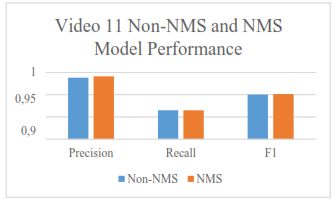Intelligent Eyes on the Battlefield: Developing an AI-Vision Based Military Vehicle and Infantry Detection System
DOI:
https://doi.org/10.47355/jaset.v3i2.63Keywords:
YOLO, Image Recognition, Military system, ReconnaissanceAbstract
The importance of accurate, real-time intelligence in modern warfare is crucial, especially in reconnaissance and surveillance operations. Currently, drones are widely used for reconnaissance, but generally rely only on the operator's ability to monitor operation targets. This research is aimed at developing an AI vision assistance system to enhance the ability to detect military vehicles and infantry. The method used is computer vision trained to recognize and differentiate several military objects. The YOLO model is used to detect and distinguish objects. To improve detection capabilities, the YOLO v8 model was retrained with an additional dataset sourced from battle recordings on the battlefield. The results show a detection accuracy rate of 95% in detecting vehicles and infantry under normal visual conditions. The model from this research can be used to enhance the capabilities of reconnaissance drones and the effectiveness of monitoring operations.
References
I. Goodfellow, Y. Bengio and A. Courville, Deep Learning, The MIT Press, 2016.
C. François, Deep Learning with Python, Manning, 2017.
H. Muhammad, "YOLO-v1 to YOLO-v8, the Rise of YOLO and Its Complementary Nature toward Digital Manufacturing and Industrial Defect Detection," Machines, pp. 667-693, 2023.
J. Terven and D. Cordova-Esparza, "A Comprehensive Review of YOLO Architectures in Computer Vision: From YOLOv1 to YOLOv8 and YOLO," Machine Learning and Knowledge Extraction, 2023.
A. Z. M. J. Mariya Yao, Applied Artificial Intelligence: A Handbook For Business Leaders, TOPBOTS Incorporated, 2018.
Y. B. a. A. C. Ian Goodfellow, Deep Learning, Cambridge: The MIT Press, 2016.
r. Chollet, Deep Learning with Python, Manning Publications, 2017.
R. Szeliski, Computer Vision: Algorithms and Applications (Texts in Computer Science) 2011th Edition, Springer, 2010.
S. J. D. Prince, Computer Vision: Models, Learning, and Inference, Cambridge University Press, 2012.
V. H. ,. R. B. Milan Sonka, Image Processing, Analysis and Machine Vision, CL Engineering, 2007.
A. B. a. C.-Y. W. a. H.-Y. M. Liao, "YOLOv4: Optimal Speed and Accuracy of Object Detection," 2020.
S. D. R. G. A. F. Joseph Redmon, "You Only Look Once: Unified, Real-Time Object Detection," In Proceedings of the IEEE Conference on Computer Vision and Pattern Recognition (CVPR), 2015.
R. E. Dupré, "Guide to Imagery Intelligence," The Intelligencer Journal of U.S. Intelligence Studies, vol. 18, pp. 61-64, 2011.
C. Carlos and C. Carolina, "A Method to Detect Victims in Search and Rescue Operation Using Template Matching," IEEE International Safety, Security, and Rescue Robotics, Workshop, 2005.
O. L. Lawal, "Tomato Detection Based On Modified YOLOv3 framework," Scientific Reports, 2021.
S. Abhishek, D. Shubhra and B. Anupama, "Object Detection for Autonomous Driving using YOLO algorithm," 2nd International Conference on Intelligent Engineering and Management, pp. 447-451, 2021.
K. Vijay and D. Bala, Data Science: Concepts and Practice 2nd Edition, Morgan Kaufmann, 2018.
C. François, Deep Learning with Python, Manning Publications, 2017.
R. Szeliski, Computer Vision: Algorithms and Applications, Springer, 2011.
M. Sonka, V. Hlavac and R. Boyle, mage Processing, Analysis, and Machine Vision 3rd Edition, CL Engineering, 2007.
S. J. D. Prince, Computer Vision 1st Edition, Cambridge University Press, 2012.
N. Ketkar, Introduction to PyTorch. In: Deep Learning with Python, Bangalore: Apress, Berkeley, CA, 2017.















